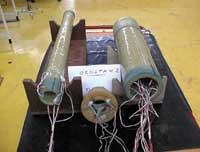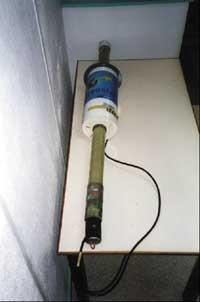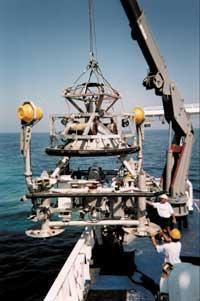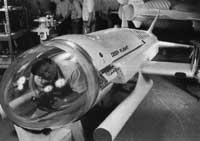Laboratory of marine cliffs
2000/11/19 Kortabarria Olabarria, Beñardo - Elhuyar Zientzia

The geostar probe is located in the vicinity of the Italian island of Ustica, in the south subsoil of the island, 2,000 meters. It has already been a month at the bottom of the sea. Although he has so far worked on preparations, from now on he will have to work. In the coming days the robot will start sending information. Seismic fluctuations under water, magnetic fields that can be found, audible sounds, possible changes in water salinity, underwater pollution, etc. are robotic probe targets. As you collect information about it, you will forward it to land.
For Giuseppe Smiriglio and Paolo Favali, the two scientists who founded the project, these moments are being exciting. Despite the time of satellites and space exploration, still on Earth itself, especially in the submarine, there are several mysteries to solve.
It has now begun work, but Geostar's journey began six years ago, when both researchers obtained funding for the project from the European Union and Italian institutions (about 11 million). Thanks to this, the Geostar robotic probe became a reality: a fully automatic underwater laboratory, able to reach a great depth and stay there for a long time. In 1998 he carried out the first underwater test in Adriatic waters. Barely two years have passed since then, but the project started on the right track and is already working.

Choosing the island of Ustica to start working is not a coincidence. "We wanted to place ourselves at the boundaries of the plate between Africa and Eurasia, because for us it is important to understand geodynamics." These are words by Giuseppe Etiopr, member of the Geostar project. "For us," says Josepe- "the underwater detection station is essential, since our seismic network is able to show what happens on earth." Of Italian origin and initiative, the Geostar project is also European, since the Italians have had the collaboration of the Institute of Earth Physics of Paris, the French of the Laboratory of Oceanography and Biochemistry of the CNRS and the Germans of the Technische Fachochschule of Berlin.
The test -when the stone lifter goes to the plaza-, when starting to work, the nervousness among those who are working on this project was the most important. "Immersion is not easy, coordination is essential. Above all, the weather must be taken into account. To be able to be located at the bottom of the sea Geostar was necessary the technical and logistic assistance of the ship Urania. "Actually the descent of the probe - says Paolo Favali- was exciting. The probe in the air weighs 4,100 kilos. Of course, that in the water is less. But that doesn't have a special meaning, the most important: so far no one has carried this type of laboratory down to 2,000 meters. In the United States, despite having all its resources, they have only managed to lower small robots of normal function."

The probe is in its workplace, so the nervousness of the placement work is just history, the responsibilities are now other. "We are beginning to worry about the issue of communications, that at least there is no cut in the communication between the laboratory and our art. The robot is starting to send a lot of information every day and we would have to be at your disposal. In case of interruption of communications the information would not be lost, the project would not be terminated, but it would be lengthened in time and this can cause some problem". According to the plan prepared by scientists, the Geostar probe will work until May in the collection of underwater information. If communication problems caused a delay, theoretically the project would not enter a state of insolution, since the probe could be submerged for another year."
At the moment only the Geostar probe is found, but if it is observed that the results of the investigations are interesting, the directors of this project will begin to submerge two other probes. One of them will dive around the island of Ustica, north of the island and at 3,500 meters deep, 1,500 meters below the current one. It is to be assumed that if the current probe is located at 2,000 meters the nervousness was predominant, the difficulties and nerves will not be minor when moving it to 3,500 meters. The third probe will dive into the Catanic coast, in an undefined place and at an indefinite depth. Therefore, the submarine robot will have the company, and not only that, if they distribute the work among three, it is possible that the time under water decreases.
Published in 7

Gai honi buruzko eduki gehiago
Elhuyarrek garatutako teknologia





